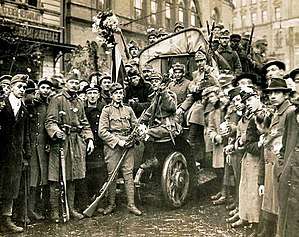Aster Revolution
| Aster Revolution | |||||||
|---|---|---|---|---|---|---|---|
| Part of the aftermath of World War I and the Revolutions of 1917–23 | |||||||
 Revolutionary soldiers wearing aster flowers, 31 October 1918 | |||||||
| |||||||
| Belligerents | |||||||
|
| ||||||
| Commanders and leaders | |||||||
| |||||||
The Aster Revolution or Chrysanthemum Revolution (Hungarian: Őszirózsás forradalom) was a revolution in Hungary led by Count Mihály Károlyi in the aftermath of World War I which led to the foundation of the short-lived First Hungarian People's Republic.[1][2]
The revolution received its name because the citizens and demobilized soldiers in Budapest began placing the aster flowers (őszirózsa: literally autumn = ősz and rose = rózsa) in their hats and caps to symbolize support for the social democratic Hungarian National Council (HNC) and Count Károlyi.
Károlyi had helped establish the Hungarian National Council which demanded the secession of Hungary from the Austro-Hungarian Empire. In the early morning hours of 31 October 1918, with support of the soldiers from the Hungarian Army, HNC protesters wearing asters helped seize public buildings throughout Budapest. Prime Minister Sándor Wekerle resigned and former Prime Minister István Tisza was murdered.
By the end of the day, King Charles IV was forced to accept the coup and Károlyi became Hungary's new Prime Minister. Károlyi then terminated the Compromise of 1867, thus formally dissolving the Austro-Hungarian union. On 13 November, Charles issued a proclamation recognizing Hungary's right to determine the form of the state and withdrawing from Hungarian affairs of state. Károlyi's provisional government proclaimed the Hungarian People's Republic on 16 November 1918, with Károlyi named as provisional president.
The Hungarian Royal Honvéd army still had more than 1,400,000 soldiers[3][4] when Mihály Károlyi was announced as prime minister of Hungary. Károlyi yielded to U.S. President Woodrow Wilson's demand for pacifism by ordering the disarmament of the Hungarian army. This happened under the direction of Béla Linder, minister of war in the Károlyi government.[5][6] Due to the full disarmament of its army, Hungary was to remain without a national defence at a time of particular vulnerability. The Hungarian self-disarmament made the occupation of Hungary directly possible for the relatively small armies of Romania, the Franco-Serbian army and the armed forces of the newly established Czechoslovakia. During the rule of Károlyi's pacifist cabinet, Hungary rapidly lost control over approx. 75% of its former pre-WW1 territories (325 411 km²) without armed resistance and was subject to foreign occupation.[7]
In March 1919, the republic was itself overthrown by a Communist putsch, which established the Hungarian Soviet Republic. Soviet Hungary soon collapsed due to internal discontent and a Romanian invasion and, after a brief revival of the People's Republic, the monarchy was restored, now as an independent country.
History
Timeline

References
- Cornelius, Deborah S. (25 February 2017). Hungary in World War II: Caught in the Cauldron. Fordham Univ Press. p. 10. ISBN 9780823233434.
- Rudnytsky, Peter L.; Bokay, Antal; Giampieri-Deutsch, Patrizia (1 July 2000). Ferenczi's Turn in Psychoanalysis. NYU Press. p. 43. ISBN 9780814775455.
- Martin Kitchen (2014). Europe Between the Wars. Routledge. p. 190. ISBN 9781317867531.
- Ignác Romsics (2002). Dismantling of Historic Hungary: The Peace Treaty of Trianon, 1920 Issue 3 of CHSP Hungarian authors series East European monographs. Social Science Monographs. p. 62. ISBN 9780880335058.
- Dixon J. C. Defeat and Disarmament, Allied Diplomacy and Politics of Military Affairs in Austria, 1918–1922. Associated University Presses 1986. p. 34.
- Sharp A. The Versailles Settlement: Peacemaking after the First World War, 1919–1923. Palgrave Macmillan 2008. p. 156. ISBN 9781137069689.
- Agárdy, Csaba (6 June 2016). "Trianon volt az utolsó csepp - A Magyar Királyság sorsa már jóval a békeszerződés aláírása előtt eldőlt". veol.hu. Mediaworks Hungary Zrt.